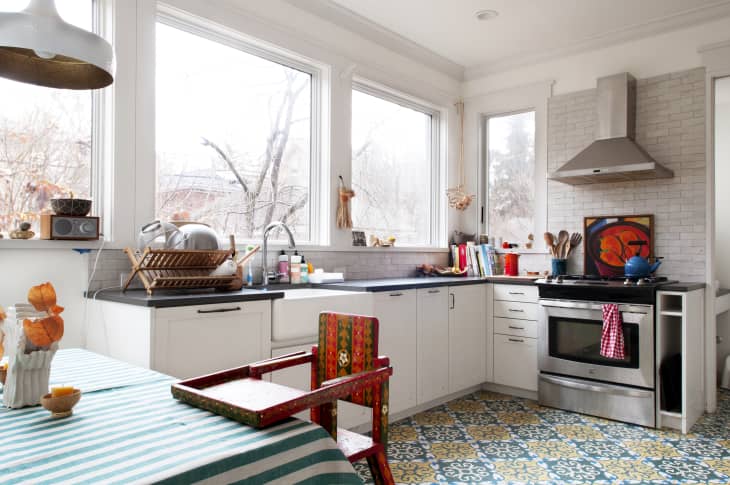Are You Over-Disinfecting Your Home? Here Are 3 Things to Know
This time last year, most of us were stocking up on cleaning supplies to protect ourselves and others from a scary, unknown virus. Back then, it was better to be safe than sorry, which meantdisinfecting any and every home surface— counters, floors, even groceries — that could potentially harbor the coronavirus.
For more content like this follow
The pandemic isn’t over, but we’ve learned a lot since then, including thatsurface transmissionisn’t a significant form of spread like we once thought. And according toElizabeth Scott, PhD, an associate professor of biology at Simmons University and co-director and founder of the Simmons Center for Hygiene and Health in Home and Community, that means now’s a great time to hone our disinfecting habits.
“Hygiene theater,” or overusing and misusing disinfecting products to create an illusion of safety, can actually pose greater risks to one’s health and the environment.
For one thing, she says, overuse of chemicals in the home can pose health risks to people with asthma or respiratory conditions. “To some degree, all disinfecting chemicals are toxic, and you need ‘toxic’ to kill bacteria,” she says. “But overusing and misusing these chemicals could pose an environmental risk.” Further,disinfecting too muchcan actuallymake certain bacteria— such as staph — stronger and resistant to disinfectants, which comes with obvious health risks.
The solution? Scott, along with theInternational Scientific Forum on Home Hygiene, suggests atargeted hygiene approach. “That means we promote the targeted use of disinfectants at the time and place where they could be of some benefit,” she says.
And for the rest of the time? Your regular (non-disinfecting) soap or cleaning solution does a good enough job. “Routine cleaning performed effectively with soap or detergent, at least once per day, can substantially reduce virus levels on surfaces,” said CDC Director Dr. Rochelle Walensky,during a White House Briefing in April.
What, exactly, does that mean for you and your disinfecting routine? Here’s what you need to know:
Use the right product for the correct task
Pretty much every cleaner contains a disinfectant these days, but that’s not as helpful as you might think — mostly because, as we’ve already covered, not every surface actuallyneedsdisinfecting. To prevent the long-term damage caused by over-disinfecting — and to save time and money — pinpoint when you actually need to disinfect and when you’re going to clean, then choose your product accordingly.
If your goal is to banish crumbs and fingerprints from a counter, thenyou’re cleaning it. In that scenario, you could use soap and water, a wet microfiber cloth, or an all-purpose spray.
如果你准备食物女伯爵r, or someone ill coughed directly on it, then it’s time to disinfect. The disinfecting product you choose — for example, a bleach-based product or anotherEPA-approved disinfectant— ultimately depends on the surface. Just make sure to clean a surface before you disinfect it!
Only disinfect surfaces that actually need it
Targeted hygiene focuses on disinfecting the surfaces most likely to have potentially harmful germs lingering on them — also called “high-touch” surfaces — such as doorknobs, light switches, toilet and sink handles, and so on. Obviously, the likelihood of these spots harboring germs goes up when someone in your home is sick, so you’d end up “targeting” them more.
On the other hand, some spaces don’t need disinfecting at all. Take your windows, for example. Unless someone is regularly licking or directly sneezing on the glass, Scott says it’s unlikely you’d need to disinfect them. Same goes for your floors. “It might seem like a germy, dirty place, but most of the time, the floor doesn’t present any risk to us unless we’re crawling around and licking it,” she says. To that end, you might consider disinfecting a floor if you have an infant crawling around — but even then, Scott says she’d only consider a floor risky if there had been an “accident” on it. (Read: bodily fluids.)
This also applies to areas that pose a risk of food-borne illness, like cutting boards, dishes, utensils, counters, and sinks. Scott says dish rags and sponges are also germ-ridden, so they require regular disinfecting (especially when you use them on food prep areas and when you’re dealing with raw meat).
Use proper technique
Disinfecting improperly can pose bigger risks than not disinfecting at all. Scott says it’s important to always按照说明product labelto ensure effective disinfecting and to avoid harmful missteps. For example, some products, including bleach, require dilution to be effective — and often, disinfectants require dwell time on surfaces to kill germs.
Safety, of course, is the top priority. Always ensure the room you’re disinfecting is properly ventilated, and to protect yourself from chemical burns, wear eye and hand protection. And it may go without saying,butnevermix bleach with other chemicals, like ammonia — doing so could create potentially lethal gases.
The bottom line: There’s nothing more important than keeping you and your loved ones safe. At times — when there’s an actual risk of germ transmission — that may involve disinfecting. But these days, “better safe than sorry” might also mean disinfecting sparingly, or in some cases, not disinfecting at all.

